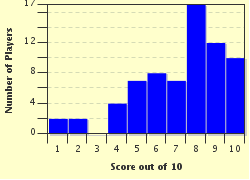Quiz Answer Key and Fun Facts
1. Our first stop at the Canning Expo is the jelly booth. We head to this area filled with colorful jellies and spreads and meet a nice woman from Georgia who won a ribbon for her scuppernong jelly. What is this fruit?
2. Our next stop in the Canning Expo is the pickling display. Here a woman proudly shows us her ribbon for her thinly sliced sweet pickles with a slightly tangy taste. She tells us the name derived during hard times in the Great Depression in the United States. What is this pickle?
3. We continue in the Canning Expo and come to the spaghetti sauce displays. This area is relatively new to the Expo and the man holding up his bottle of blue ribbon sauce states that his secret is using the oval and meaty tomato called the 'Italian Tomato'. How else is this tomato known?
4. The next section of the Canning Expo is for marmalade with its jars of preserves showing bits of peel. The blue ribbon winner was for the family who made rhubarb marmalade. They assured me it was not only delicious but perfectly safe. They mentioned this because one part of the rhubarb plant is poisonous. Which part?
5. We next halt at the Canning Expo at the salsa section. The youth who won his first place ribbon was holding up his winning salsa jar. However, I was surprised because the sauce was green! What was the name of this concoction?
6. We continue through the Canning Expo where we come to the canned vegetable area. There was a tie for first place! One of the ribbon winners created canned beets and taught us something we didn't know. What kind of canning method, for safety reasons, should be used for home canning of vegetables?
7. In the Canning Expo, the canned vegetable winner was a tie and one of the winners was holding up a mason jar. It was filled with pickled green beans. She told us they were a fantastic garnish to a tomato alcoholic drink named after an English queen. What is this drink?
8. Continuing on through the Canning Expo at the fair, we stop at the winner for the thicker spreads. The winner was letting us sample his apple butter and explaining the origin and ingredients. One of the key parts of this dish is fresh unsalted butter. True or False?
9. We continue through the Canning Expo and halt at the jam exhibit. The person that won the contest here made a delightful blueberry jam. He told us the real secret in it was the spice that he used. He said it came from the inner bark of trees and dated back to ancient times. What spice is this?
10. Our final stop in the Canning Expo is at the miscellaneous canning section. Here the blue ribbon winner was a group that made a fantastic chow-chow. What type of food is this?
Source: Author
stephgm67
This quiz was reviewed by FunTrivia editor
WesleyCrusher before going online.
Any errors found in FunTrivia content are routinely corrected through our feedback system.

